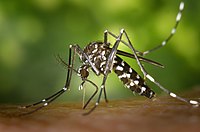
Photo from wikipedia
Ovitraps can detect Aedes vectors at an early stage and can serve as an alarm indicator for outbreak prediction. This study aimed to summarize the available literature about the ovitrap… Click to show full abstract
Ovitraps can detect Aedes vectors at an early stage and can serve as an alarm indicator for outbreak prediction. This study aimed to summarize the available literature about the ovitrap system and to determine its feasibility, required resources and costs when installing and maintaining this vector surveillance system in the municipality of Los Patios, Colombia. A scoping review to assess the role of ovitraps as a tool for Aedes vector surveillance was conducted. The subsequent fieldwork consisted of mapping the municipality, manufacturing, and installing 40 ovitraps in 10 blocks, revising them weekly for 4 weeks by two half-time employed vector control technicians, and carrying out a cost analysis. A total of 38 studies were included in this review showing that ovitraps had a better performance than other entomological surveillance methods and a positive correlation with other entomological and disease variables. From the field results over 4 weeks, a high proportion of positive ovitraps (80%, 90%, 75%, 97.5%) and positive blocks (100%) as well as a good acceptance by house owners (76.9%), were identified. Operational indicators such as average installation time of the ovitraps (10h15 m), weekly reading and reinstallation (on average 7h27 m) and the cost of the intervention (COL$1,142,304.47/US$297) were calculated. Literature shows that ovitraps are sensitive to detect the presence of Aedes mosquitoes, providing data efficiently and timely for outbreak prediction. The field testing showed it is an affordable and feasible method in the context of a Colombian municipality and similar endemic areas.
Journal Title: Pathogens and global health
Year Published: 2022
Link to full text (if available)
Share on Social Media: Sign Up to like & get
recommendations!